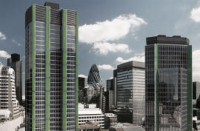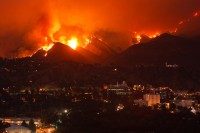By Margaret Kriz Hobson, NationalJournal.com
Should the Environmental Protection Agency be required to publicly defend its finding that greenhouse gases endanger public health and welfare?
In April, the EPA released a proposal concluding that carbon dioxide and other global warming pollutants cause health problems. Now the agency is poised to release the final version of that ruling. But the U.S. Chamber of Commerce argues that before the decision is finalized, EPA should be required to defend its scientific conclusions in front of an administrative law judge. Chamber officials and other critics claim that the Obama administration is suppressing internal agency studies that disagree with the proposed endangerment finding.
Should the climate change data be reviewed in a public administrative law hearing? Would a public hearing make any difference? Or is the hearing request just an excuse to delay the agency’s climate change decision?
Response from William O’Keefe, CEO, George C. Marshall Institute
If the Obama Administration is serious about science guiding policy, EPA will grant the Chamber’s petition for a hearing on the science of climate change. And, a public hearing should be structured to comply with the standards of scientific evidence established by the Supreme Court in its Daubert v Merrill Dow Pharmaceutical decision. The ramifications of EPA regulation of greenhouse gases and potentially land use are significant enough to justify a re-examination of the scientific foundation for regulatory action.
An objective hearing would demonstrate that the weight of scientific evidence on climate change does not support an endangerment finding that human activities are causing climate change and that it will harm human health and the environment. An asserted scientific consensus on the role of human activities in climate change is based on a judgment by the IPCC in its Summary for Policy Makers that human activities are mostly responsible for warming in recent decades and that continued warming could lead to serious environmental damage later this century. However, that conclusion is not supported by the weight of evidence in the IPCC’s assessment report which clearly shows that the extent of scientific uncertainty makes any such finding nothing more than professional conjecture. The IPCC identifies nine components of radiative forcing but concludes that a high degree of scientific understanding exists for only two of them. Given such a limited understanding of the climate system, attribution conclusions and projections are model derived conjecture; not scientific facts.
Indeed, in 2001, the National Academy of Sciences concluded that projections of future climate change were subject to revision, upward or downward, as more knowledge was gained. Nothing has occurred in science since then to make that conclusion obsolete.
The so called “human finger print”, increased water vapor in the lower atmosphere, has not been detected and the climate models which are the foundation of the asserted consensus are not reliable and have not been validated. In deed, if any one of the IPCC’s scenarios is run through its ensemble of models, there is as much variability in results as produced if anyone scenario is run through all of the models. Such variability is evidence of a lack of scientific understanding about such factors as clouds, solar impacts, ocean currents, natural variability, aerosols, and other important variables.
The warming that occurred between 1976 and 1998 has been the basis of concern and proposed action to limit greenhouse gas emissions but research by Dr. Roy Spencer of the University of Alabama suggests that that warming was due to the Pacific Decadal Oscillation which could be the cause of a lack of significant warming over the past decade. The fact that no significant warming has occurred since 1998 and that climate models over predict global temperatures without adjustments are compelling reasons for reassessing what we really know about the climate system and the state of scientific knowledge. A hypothesis about human attribution should not be sufficient for an endangerment finding and regulations related to it.
See response by Senator James Inhofe here. See all 5 responses to date here.
By Martin LaMonica
The future of green technology is algae-cultivating buildings, artificial trees, and lots of white roofs, according to the U.K.’s Institution of Mechanical Engineers.
The group on Thursday released a report that recommends governments fund research on geoengineering, or large-scale fixes for climate change. The report, a year in the making, is targeted at policymakers and is meant to inspire engineers to develop ways to cut greenhouse gas concentrations in the atmosphere.

London, if it gets an algae-growing makeover.
As concern grows over climate change, a number of geoengineering ideas have been proposed, including placing mirrors in space to reflect sunlight or shooting sulfur particles into the stratosphere, which would also have a cooling effect.
However, in its analysis, the Institution of Mechanical Engineers found that most promising geoengineering techniques can be done on Earth. It argues that a handful of technologies be deployed at large scale, along with other strategies, to mitigate the effects of climate change.
At the top of the list are artificial trees, which are mechanical devices that can absorb carbon dioxide from the air faster than trees and then sequester that gas underground.
The institution’s report refers to the research done by Columbia University Professor Klaus Lackner, who is researching the concept and materials to absorb large amounts of CO2. Also required are underground storage formations, such as depleted oil wells. At a cost of $20,000 per tree, the institution concludes that it’s the most practical approach.
Cultivating algae to make liquid fuel is one of the most active areas of research in biofuels. The institution recommends that algae be incorporated into buildings so algae can be grown at a large scale.
How artificial trees, which capture carbon from the air, could be deployed alongside wind turbines.
(Credit: Institution of Mechanical Engineers)Engineers envision that long plastic tubes, called photobioreactors, be integrated into building designs or retrofitted onto existing skyscrapers.
Algae would grow from pumped-in carbon dioxide and sunlight and be harvested for use either as a liquid fuel to run in a combined heat-and-power unit or turned into biochar, or charcoal used as a soil conditioner that also sequesters carbon from the air.
Finally, the institution says that buildings should be retrofitted with reflective roofs to deflect the sun’s rays. In the past months, U.S. Energy Secretary Steven Chu has publicly touted this relatively low-tech approach, which was studied in-depth at the Lawrence Livermore Laboratory last year.
Although proposing billions of white roofs doesn’t appear to be controversial, many other geoengineering ideas are. For example, scientists have warned about the environmental impact--or effectiveness--of “seeding” the ocean with iron to spur growth of plankton to sequester carbon.
In anticipation of a report on geoengineering from the U.K.’s Royal Society next week, watchdog ETC Group warned against unintended consequences from large-scale projects. “Even the most careful computer models won’t be able to predict what will happen if an experiment is scaled-up and moved out of doors,” the group said in a statement Friday. See post here.
Potential new fiascos in the long history of unfortunate enviro driven consequences like the banning of DDT to protect the songbirds that resulted in 40,000,000 unnecessary malaria deaths, the lobbying against genetically modified seeds that can be disease, insect and drought resistant and enable food to be grown successfully more places, the banning of harmless CFCs and replacement with even more potent HFCs due to faulty science by ‘scientists’ like Susan Solomon and Ralph Cicerone, the pushing of ethanol from corn resulting in a spike in corn prices and food riots worldwide, a company (GE- the Green Enron) that pioneered in the incandescent light bulb that brightened our lives lobbied successfully for compact flourescent bulbs that contain mercury that will contaminate landfills (see here why LED’s make more sense for the future), the prevention of tree stand thinning and brush removal that inevitably leads to worse wildfires like those now burning in California (see photo taken from JPL lab below), litigation leading to cancellation of proposed new fossil fuel and nuclear power plants designed to meet ever growing energy needs virtually assuring a future of brownouts and blackouts, and if we are not able to stop it, with Cap-and-Tax or EPA regulations, a huge increase in taxes for all Americans, a major loss of jobs, and a second far worse economic collapse.

By Krystle Russin on Heartland.org
Refrigerant chemicals that have replaced substances banned for allegedly harming the ozone layer are poised to become a major source of global warming, according to a study conducted by the Netherlands Environmental Assessment Agency.
By the year 2050, hydrofluorocarbons (HFCs) - which replaced chlorofluorocarbons (CFCs) banned by the Montreal Protocol - may exacerbate carbon dioxide-related global warming by 19 percent, according to the study.
Unintended Consequences
Since the Montreal Protocol took effect in 1989, HFCs have replaced CFCs as the chemicals of choice for refrigeration and air conditioning. A decade later, there appears to be little difference in seasonal and annual fluctuations of the Earth’s ozone layer, but the greater prevalence of HFCs has the Netherlands Environmental Assessment Agency (NEAA) worried about global warming.
“Increased use and emission of HFCs could largely undo the climate benefits already achieved by the Montreal Protocol,” said NEAA in an issue summary accompanying the study.
“The climatologists’ opinion was we’ve got to stop using CFCs because they’re affecting the ozone and increasing the greenhouse effect. Yet we’ve replaced it with another chemical that is still a greenhouse gas. We traded one greenhouse gas for another greenhouse gas. Anyone should’ve seen this coming,” said Sterling Burnett, a senior fellow at the National Center for Policy Analysis.
Valuable Products Banned
“CFC was the original refrigerant”, Burnett explained. “It was better than anything else on the market because it had a lot of virtues. It wasn’t toxic to humans. It was a good insulator. It worked well and wasn’t harmful, and then we started worrying about the ozone layer. There are no refrigerators or venting at the poles, and CFCs don’t seem to break up ozone layers over the cities where they are released. I always found that puzzling.”
Environmental policy analyst Drew Thornley said, “This latest research highlights the potential unintended consequences of government regulation, and it further supports the position that drastic measures to curb greenhouse-gas emissions are premature, insofar as research is ongoing and current questions remain unanswered and new questions emerge.
“As an alternative to hasty, sweeping, climate-fighting mandates and regulations, a better approach is to take whatever time is necessary to continue important research and gather the information that will put us in a better position to protect the environment and consumers,” Thornley added.
Read more here. H/T TWTW.


